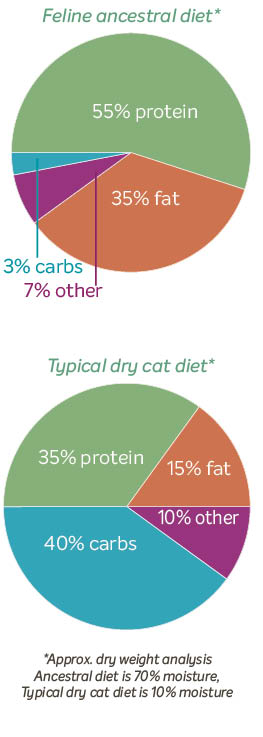Your cat will thrive on a high-protein, high-moisture diet with moderate levels of fat and very low levels of carbohydrates.

Living with a small lion
Today’s house cat is thought to be a descendant of the small wild cat felis lythica, native to the deserts of Northern Africa. Evolving from such a dry climate might explain their ability to survive long periods of time without drinking water when eating a strict diet of moisture-laden live prey containing about 70% moisture. The early twentieth-century cat spent much of his time outdoors catching mice and other vermin, which met his daily water needs. As cats have progressively moved indoors, however, their diet has grown far less juicy, leading to dehydration if they are not fed high moisture canned or raw meat diets.
Don’t feed your cat like a dog
Cats and dogs evolved along different paths, with many genetic, metabolic, and anatomical differences. Canine domestication led dogs to evolve as facultative carnivores (meaning discretionary or optional), capable of digesting some plant-based foods from the waste of early human farming settlements, even though meat was still their food of choice. Cats remained obligate carnivores, requiring meat and the specific nutrients found only in meat for their survival. Illustrating this point are two nutrients, arachidonic acid, an important fatty acid, and Vitamin A, both of which dogs can synthesize from plant sources. Cats cannot, and must get each of those nutrients from animal sources only.
More meat matters
A cat’s natural diet is high in protein with moderate fat and very low carbohydrates. Proteins are the building blocks of the body, forming the structure of muscles, organs, bones, skin, teeth, and hair. When protein is consumed, the body breaks it down into individual amino acids and “restrings” them to form all the different proteins necessary for growth and tissue repair and to make hormones, enzymes, and immune cells required on a daily basis. While dogs can make the proteins they require with 10 essential amino acids, cats need an extra one; taurine is essential for cats but not for dogs, and must be derived from animal sources exclusively. Without dietary taurine, cats will develop serious eye and heart disease.
Not all livers are alike
The biggest metabolic difference between canines and felines is that of liver function. Humans and dogs will utilize carbs first for their energy needs and then utilize fats, sparing dietary protein for higher purposes. But cats, whose ancestral diet contained so little carbohydrate that they do not even possess taste buds for sweetness, evolved on such protein-rich diets that they haven’t developed the ability to conserve protein. Enzymes in their highly specialized livers convert amino acids to glucose that the body can use for energy in a process called gluconeogenesis. The feline liver is always in hyperdrive, turning amino acids into fuel, and without enough dietary protein, the body will begin to cannibalize its own muscle tissue. That is why muscle wasting is common in cats who are ill and won’t eat or on low-protein senior or prescription diets formulated with the now-discredited belief that it will benefit kidney function. Symptoms of protein deficiency include muscle atrophy and coarse, brittle coat.
Treat cats like the carnivores that they are
Today’s top three medical issues for cats, feline lower urinary tract disease (FLUTD), feline obesity, and feline diabetes, are all related to diet. Having inherited a low thirst drive, house cats who consume more than half of their calories from dry foods can become chronically dehydrated, and without adequate amounts of water to flush out toxins and metabolic wastes, they are far more susceptible to urinary tract blockages and kidney problems. The twin epidemics of obesity and diabetes can be traced directly to an overabundance of carbohydrates, which is an unnatural food for felines whether it comes from grains or other starches. Our experience has shown that these health problems can be alleviated by following a true carnivore diet of mostly animal proteins and fats, with at least 70% moisture and very few carbs.
Transitioning to a healthier diet
Luckily, finding the right diet for your cat is not difficult with help from the knowledgeable staff at All The Best. We literally search the world for the most nutritious and biologically appropriate foods. Our years of experience have taught us that cats have a very simple palate, with a clear preference for certain proteins and flavors. They tend to be texture-driven in their canned food preferences, and we can help you discover which they like best, whether it’s a smooth paté, chunks in gravy, or shredded meat in a simple broth. Raw foods come in many options, too, including scoopable grinds, quick thawing small bites, and freeze-dried. If your cat is fixated on her kibble, there are ways to gradually introduce new foods without them giving it up entirely. Even achieving 50% canned or raw is a success, and if you can go higher—good for you and your cat!
Tips on switching to canned or raw food
• Remove all food the night before introducing the new diet – a hungry cat will be more accepting.*
• Try a variety of proteins and textures
• Add tuna water or a few bonito flakes to enhance flavor
• Warm up food to mimic the body temperature of prey
• Don’t get discouraged – it can take time and patience to get it right
*Do not let your cat go without food for more than 24 hours

